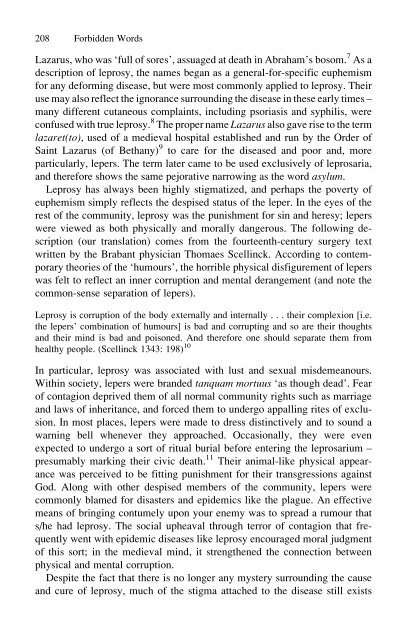Forbidden Words: Taboo and the Censoring of Language
Forbidden Words: Taboo and the Censoring of Language
Forbidden Words: Taboo and the Censoring of Language
Create successful ePaper yourself
Turn your PDF publications into a flip-book with our unique Google optimized e-Paper software.
208 <strong>Forbidden</strong> <strong>Words</strong><br />
Lazarus, who was ‘full <strong>of</strong> sores’, assuaged at death in Abraham’s bosom. 7 As a<br />
description <strong>of</strong> leprosy, <strong>the</strong> names began as a general-for-specific euphemism<br />
for any deforming disease, but were most commonly applied to leprosy. Their<br />
use may also reflect <strong>the</strong> ignorance surrounding <strong>the</strong> disease in <strong>the</strong>se early times –<br />
many different cutaneous complaints, including psoriasis <strong>and</strong> syphilis, were<br />
confused with true leprosy. 8 The proper name Lazarus also gave rise to <strong>the</strong> term<br />
lazaret(to), used <strong>of</strong> a medieval hospital established <strong>and</strong> run by <strong>the</strong> Order <strong>of</strong><br />
Saint Lazarus (<strong>of</strong> Bethany) 9 to care for <strong>the</strong> diseased <strong>and</strong> poor <strong>and</strong>, more<br />
particularly, lepers. The term later came to be used exclusively <strong>of</strong> leprosaria,<br />
<strong>and</strong> <strong>the</strong>refore shows <strong>the</strong> same pejorative narrowing as <strong>the</strong> word asylum.<br />
Leprosy has always been highly stigmatized, <strong>and</strong> perhaps <strong>the</strong> poverty <strong>of</strong><br />
euphemism simply reflects <strong>the</strong> despised status <strong>of</strong> <strong>the</strong> leper. In <strong>the</strong> eyes <strong>of</strong> <strong>the</strong><br />
rest <strong>of</strong> <strong>the</strong> community, leprosy was <strong>the</strong> punishment for sin <strong>and</strong> heresy; lepers<br />
were viewed as both physically <strong>and</strong> morally dangerous. The following description<br />
(our translation) comes from <strong>the</strong> fourteenth-century surgery text<br />
written by <strong>the</strong> Brabant physician Thomaes Scellinck. According to contemporary<br />
<strong>the</strong>ories <strong>of</strong> <strong>the</strong> ‘humours’, <strong>the</strong> horrible physical disfigurement <strong>of</strong> lepers<br />
was felt to reflect an inner corruption <strong>and</strong> mental derangement (<strong>and</strong> note <strong>the</strong><br />
common-sense separation <strong>of</strong> lepers).<br />
Leprosy is corruption <strong>of</strong> <strong>the</strong> body externally <strong>and</strong> internally . . . <strong>the</strong>ir complexion [i.e.<br />
<strong>the</strong> lepers’ combination <strong>of</strong> humours] is bad <strong>and</strong> corrupting <strong>and</strong> so are <strong>the</strong>ir thoughts<br />
<strong>and</strong> <strong>the</strong>ir mind is bad <strong>and</strong> poisoned. And <strong>the</strong>refore one should separate <strong>the</strong>m from<br />
healthy people. (Scellinck 1343: 198) 10<br />
In particular, leprosy was associated with lust <strong>and</strong> sexual misdemeanours.<br />
Within society, lepers were br<strong>and</strong>ed tanquam mortuus ‘as though dead’. Fear<br />
<strong>of</strong> contagion deprived <strong>the</strong>m <strong>of</strong> all normal community rights such as marriage<br />
<strong>and</strong> laws <strong>of</strong> inheritance, <strong>and</strong> forced <strong>the</strong>m to undergo appalling rites <strong>of</strong> exclusion.<br />
In most places, lepers were made to dress distinctively <strong>and</strong> to sound a<br />
warning bell whenever <strong>the</strong>y approached. Occasionally, <strong>the</strong>y were even<br />
expected to undergo a sort <strong>of</strong> ritual burial before entering <strong>the</strong> leprosarium –<br />
presumably marking <strong>the</strong>ir civic death. 11 Their animal-like physical appearance<br />
was perceived to be fitting punishment for <strong>the</strong>ir transgressions against<br />
God. Along with o<strong>the</strong>r despised members <strong>of</strong> <strong>the</strong> community, lepers were<br />
commonly blamed for disasters <strong>and</strong> epidemics like <strong>the</strong> plague. An effective<br />
means <strong>of</strong> bringing contumely upon your enemy was to spread a rumour that<br />
s/he had leprosy. The social upheaval through terror <strong>of</strong> contagion that frequently<br />
went with epidemic diseases like leprosy encouraged moral judgment<br />
<strong>of</strong> this sort; in <strong>the</strong> medieval mind, it streng<strong>the</strong>ned <strong>the</strong> connection between<br />
physical <strong>and</strong> mental corruption.<br />
Despite <strong>the</strong> fact that <strong>the</strong>re is no longer any mystery surrounding <strong>the</strong> cause<br />
<strong>and</strong> cure <strong>of</strong> leprosy, much <strong>of</strong> <strong>the</strong> stigma attached to <strong>the</strong> disease still exists

















